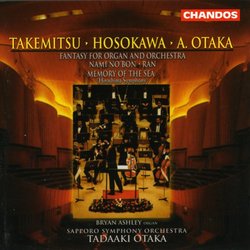| All Artists: Atsutada Otaka, Toru Takemitsu, Toshio Hosokawa, Tadaaki Otaka, Sapporo Symphony Orchestra Title: Atsuada Otaka: Fantasy for Organ and Orchestra; Toru Takemitsu: Nami no Bon; Ran; Toshio Hosokawa: Memory of the Sea Members Wishing: 0 Total Copies: 0 Label: Chandos Release Date: 2/27/2001 Genres: Soundtracks, Classical Styles: Forms & Genres, Concertos, Symphonies Number of Discs: 1 SwapaCD Credits: 1 UPC: 095115987629 |
Search - Atsutada Otaka, Toru Takemitsu, Toshio Hosokawa :: Atsuada Otaka: Fantasy for Organ and Orchestra; Toru Takemitsu: Nami no Bon; Ran; Toshio Hosokawa: Memory of the Sea
CD Details |
CD ReviewsJapan's French Connection Thomas F. Bertonneau | Oswego, NY United States | 03/24/2001 (4 out of 5 stars) "The stubborn independents of classical music recording deserve abundant praise. They take risks to bring new or unjustly neglected repertory into circulation, even while former Titans of the business like Sony, Polygram, and BMG retrench into a few opera stars in mixed recital and various "crossover" projects. To whom will the new Chandos disc of music for organ and orchestra by Japanese composers appeal? A better question is, to whom ought it appeal? Admirers of the late Toru Takemitsu (1930-1996) will want it for his two film-score suites, "Nami no Ban" (1988) and "Ran" (1985). Aficionados of the organ-orchestra combination will find much to contemplate in Atsutada Otaka's (born 1944) "Fantasy for Organ and Orchestra" (1999) and in Toshio Hosokawa's (born 1955) "Memory of the Sea: Hiroshima Symphony" (no date given) - two substantial compositions in accessible idiom. Otaka studied with Maurice Durufflé; his "Fantasy" stems from the French tradition and remains close to it. Symphonic in its dimensions, the "Fantasy" will remind listeners of works by Dupré and Jongen. It is romantic in spirit and only mildly modernistic in gesture. Despite the notes, it is not at all reminiscent of Poulenc's irritating Organ Concerto; Otaka is not prone to Poulenc's regrettable taste for solecism. Hosokawa's "Hiroshima Symphony" delivers something quite other than what the title leads us to expect. We expect a sonic gnashing of teeth. The composer gives us instead an impressionistic meditation on the recovered Hiroshima of the 1950s and 60s, the time when he was growing up there, a beautiful city of gardens whose atmosphere is colored by the proximity of the sea. Hosokawa's aesthetic, like Otaka's, is French. (So, for that matter, is Takemitsu's - Japanese composers with an Austro-German orientation, like Saburo Moroi [1903-1977], have been little recorded.) Here one does encounter a few "avant-garde" gestures culled from the vocabularies of Varèse, Ligeti, and Penderecki, but the language has been tamed. The score calls for two "banda," small instrumental groups stationed elsewhere in the auditorium than on-stage. This kind of effect is notoriously difficult to represent in the stereophonic sound-theater, but the Chandos engineers create a sense of depth and spaciousness in which the groups do sound distant. The performances are by the Sapporo Symphony Orchestra under Tadaaki Otaka, younger brother of Atsutada. T. Otaka has worked with Chandos before, not coincidentally on a program of César Franck with the BBC National Orchestra of Wales. This issue does what entrepreneurial music-recording should do - bring worthwhile new knowledge to music-lovers. Recommended."
|


 Track Listings (12) - Disc #1
Track Listings (12) - Disc #1